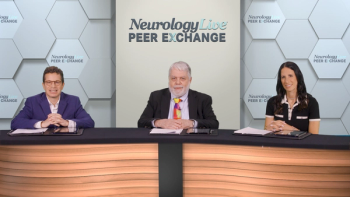
S1P Receptor Modulator Treatment Selection in RRMS
Considerations that affect which S1P receptor modulator may be used to treat relapsing-remitting multiple sclerosis, and how to best utilize them during COVID-19.
Episodes in this series

Jennifer Graves, MD, PhD, MAS: Dr Shah, would you like to add anything on this discussion of S1P [sphingosine-1-phosphate]–based drugs?
Suma Shah, MD: I’ve enjoyed learning about S1P inhibitors over the last few years, particularly to build on what we knew and loved about fingolimod since it’s been around, as we learn about siponimod. The one thing I’ll highlight is the way that the siponimod EXPAND trial was run was looking at folks who had a mean age since symptom onset of about 16 and a half years in particular. That was powerful to me. I don’t think many of our studies are done that way. They’re often patients who are treatment-naive, often with comparators that are placebo or active, but interferons or glatiramer acetate.
The EXPAND trial helped me feel that this FDA indication that we have for active secondary progressive MS [multiple sclerosis] at least looked at the correct population. That’s the 1 change that has come in the last 3 years since this has been approved, the use of S1P inhibitors, and many other medications that followed suit with their FDA approvals for active secondary progressive MS. Siponimod is the only one with the data really looking at that particular patient population and their EDSS [Expanded Disability Status Scale] and looking for confirmed disability progression over at least 3 months to show that there was an improvement. It’s modest, but it’s the first time that’s been done. That holds a lot of promise for how we look at secondary progression in the future.
Jennifer Graves, MD, PhD, MAS: Would you both comment on if there are distinguishing features between ozanimod, ponesimod, fingolimod, and siponimod? Other than things that might be particular to study design, do you think there are distinguishing features of the newer S1P receptor drugs ozanimod and ponesimod?
Suma Shah, MD: With ozanimod specifically, the incidence of bradycardia that we’ve seen in the clinical trials and in clinical practice is decreased. As Dr Macaron mentioned, macular edema is seen in 1% to 2% in many of these trials, and it’s even reduced in ozanimod and ponesimod. For folks who may be inclined to be cautious about that, if we’re looking for S1Ps, the risk of bradycardia being decreased may help raise that to the top of the list. However, there are some limitations there, too. Many of our patients are on SSRI [selective serotonin reuptake inhibitor] and SNRI [serotonin–norepinephrine reuptake inhibitor] antidepressants. We’ve been counseled or cautioned on their use concurrently with ozanimod, and that limits my ability to offer it as an option for patients when there are other S1P inhibitors that don’t have that same concern.
Gabrielle Macaron, MD: I’d like to add to this very important point about drug interactions with these selective S1P inhibitors. With siponimod, there are some medications that can inhibit or induce the cytochrome P2C9, which is the enzyme that metabolizes siponimod. It’s very important to properly review patient medications. For example, warfarin is one of the medications that might increase the levels of siponimod. Siponimod might not be the best choice for patients who have to take warfarin for any reason.
Jennifer Graves, MD, PhD, MAS: I have 2 thoughts about ozanimod compared with fingolimod. One of the early interesting pieces of data is it looked like the absolute lymphocyte count dropped less. Do you think that’s significant for safety in any way, in terms of general risk of infections or living in the time of the pandemic? Do you think that confers any benefit that it drops the lymphocytes less, in at least what you can measure in the blood?
Suma Shah, MD: Not a whole lot. Dr Macaron, you were saying?
Gabrielle Macaron, MD: I agree, not a whole lot. Grade 4 lymphopenia is definitely associated with higher risk of infection, but many of the infections that have been reported in the long term with fingolimod weren’t associated with severe lymphopenia. For specifically what you were mentioning with the vaccine and COVID-19, we can’t expect better vaccine response from 2 drugs that have the same mechanism of action that will hide lymph nodes so that they can’t meet this antigen and can’t mount an immune response. I’d consider that this whole class of medications has a similar risk, and then it’s all statistics. In the individual patient, the risk is always here.
Jennifer Graves, MD, PhD, MAS: With respect to vaccine response, we had a recent surprise that S1P drugs—largely reported as fingolimod in the studies—have had a decreased vaccine response that most of us didn’t anticipate, possibly because the lymphocytes that are sequestered somehow aren’t able to respond to these largely mRNA vaccines that have been studied in patients with MS. To my knowledge, it’s an open question. I don’t think I’ve seen any data comparing fingolimod with ozanimod and vaccine response. That’s potentially an interesting question. You also mentioned that there’s less cardiovascular risk associated with ozanimod. I presume you implied that it’s the titration that individuals can do with ozanimod that allows people who may not feel they can come in for the 6-hour observation to at least have that titration option.
Thank you for watching this NeurologyLive® Peer Exchange. If you enjoyed the content, please subscribe to our e-newsletters to receive upcoming Peer Exchanges and other great content right in your inbox.
Transcript edited for clarity.
Newsletter
Keep your finger on the pulse of neurology—subscribe to NeurologyLive for expert interviews, new data, and breakthrough treatment updates.

































